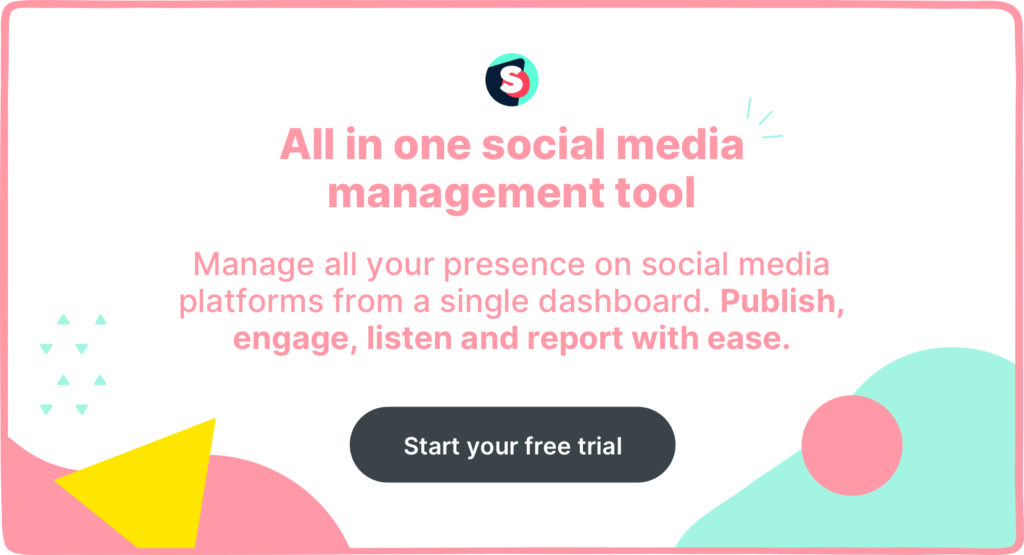Summarize this article via
If you’ve actually worked in social media management—whether you’re an in-house marketer, an agency lead, or part of a growing team—you already know that picking the right social media marketing platform is all about what works in practice, not just in a demo.And that’s exactly why we’re looking at Agorapulse alternatives. While Agorapulse is a well-known platform in the industry, it isn’t always the perfect fit for every team. Some marketers need more flexible pricing, others want advanced reporting, or a simpler interface for day-to-day publishing and engagement. Exploring alternatives ensures you can find the tool that actually matches your workflows, budget, and growth stage.That’s why we actually tested these tools ourselves. We signed up, connected accounts, and used them for real publishing, engagement, social listening, and reporting tasks. And now, we’re sharing our honest takes by looking at the data—warts and all.When selecting which tools to include, we considered:
Pricing – affordability and value for money
Features – breadth and depth of capabilities
Usability – ease of use and learning curve
Reporting – analytics quality and flexibility
Team collaboration – workflows, roles, and permissions
Why choosing the right social media management tool matters more than ever
It’s easy to fall for a slick interface or a well-run sales demo. But once you’re a few weeks into using a new platform, things start to reveal themselves. Glitches, missing features, clunky UX—all the stuff they didn’t mention on the call. And by then, you’ve already spent time migrating, onboarding your team, and maybe even paying for a year upfront.
If you browse reviews on G2 or Capterra, you’ll quickly notice: this category is all over the place. A platform built for influencer campaigns gets listed next to enterprise engagement tools. Some tools are built for solo creators, while others are built for brands managing 50+ accounts.
Everyone is a competitor to everyone—at least according to the tags. But that’s not helpful when you’re trying to compare based on actual needs.
Here are just a few reasons why choosing the right tool upfront is crucial:
1. Some platforms look great… until you actually use them
We’ve encountered tools with frequent publishing failures, delayed notifications, or interfaces that just don’t scale well when managing more than a few accounts. These things won’t show up during a demo—but they’ll cost you time (and client trust) later.
2. Many tools focus too much on content scheduling
Publishing is important, but if you’re managing a brand or clients, you also need a social inbox, competitor tracking, and social listening. A lot of platforms skip these entirely—or make them paid add-ons—leaving you to juggle multiple tools to get basic work done.
3. Collaboration and reporting can make or break your workflow
If you’re working with a team, you need approval workflows, clear roles, and client-friendly reporting. Not every platform handles this well—and sometimes, what’s billed as a “collaboration feature” is really just a shared login.
4. You’ll outgrow limited tools faster than you think
What works when you’re managing two accounts might not work at scale. You don’t want to go through the whole switching process again six months from now. Choosing a tool that can grow with you is key.
5. AI hype doesn’t always equal real value
Yes, AI is everywhere right now. But a lot of platforms use it in ways that feel more like a gimmick than a productivity boost. Tools that promise to “write your content for you” often deliver generic filler. On the other hand, platforms that use AI to streamline engagement, summarization, or sentiment analysis can actually save you time—if it’s implemented well.
Why look for an Agorapulse alternative?
Agorapulse is well-regarded for its clean UX and reliable engagement tools, but it’s not always the best fit—especially when it comes to pricing and team scalability.
One major concern is per-user pricing. While it may appear affordable at first glance, the cost can skyrocket as your team grows. For example, if your customer support or social media team includes 5–10 people handling replies and engagement, you’ll quickly find yourself paying enterprise-level prices. And the functionality doesn’t necessarily scale with the cost.
It’s also worth pointing out that premium pricing doesn’t always guarantee better technology. Many lesser-known tools are just as secure, stable, and full-featured—sometimes even more so—because of faster product development cycles and tighter feedback loops. In fact, if you browse through reviews on G2 or Capterra, you’ll notice this category is a bit chaotic: platforms with very different strengths are often lumped together as direct competitors.
That’s why we tested these tools ourselves—to move beyond marketing claims and give you a clearer picture of which platforms actually meet different real-world needs.
6 strong alternatives to Agorapulse
Before we dive in, remember: each tool excels in different ways.
We analyzed each of them with real publishing, engagement, listening, and reporting tasks. The goal is to help you find the Agorapulse alternative that best fits your team’s needs and budget.
1. Sociality.io

Best for: All-in-one social media management with AI, built for teams and agencies
Founded: 2015
Pricing: Starts at $99/month
Sociality.io offers a full suite of tools: publishing, engagement, social listening, competitor tracking, and analytics—with AI features in every module. It’s particularly strong when it comes to team collaboration (with unlimited user plans) and is used by customer experience teams along with social media teams who measure the performance of social media accounts.

Pros of Sociality.io:
- All needed features are available; social media publishing, analytics, competitor tracking, social inbox and social listening
- User friendly interface
- AI-powered reporting and analysis
- Instagram, TikTok, Facebook, Youtube, Linkedin account analytics
- Security+ to feature with 2FA, enforce strong passwords and log out sessions
- Excellent customer support
- Multi-brand management for agencies
- User-friendly social media management app
Cons of Sociality.io:
- Lack of ad management (but it’s not a common feature in every SMM tool though.)
- Lack of Meta Threads as a channel
2. Sendible
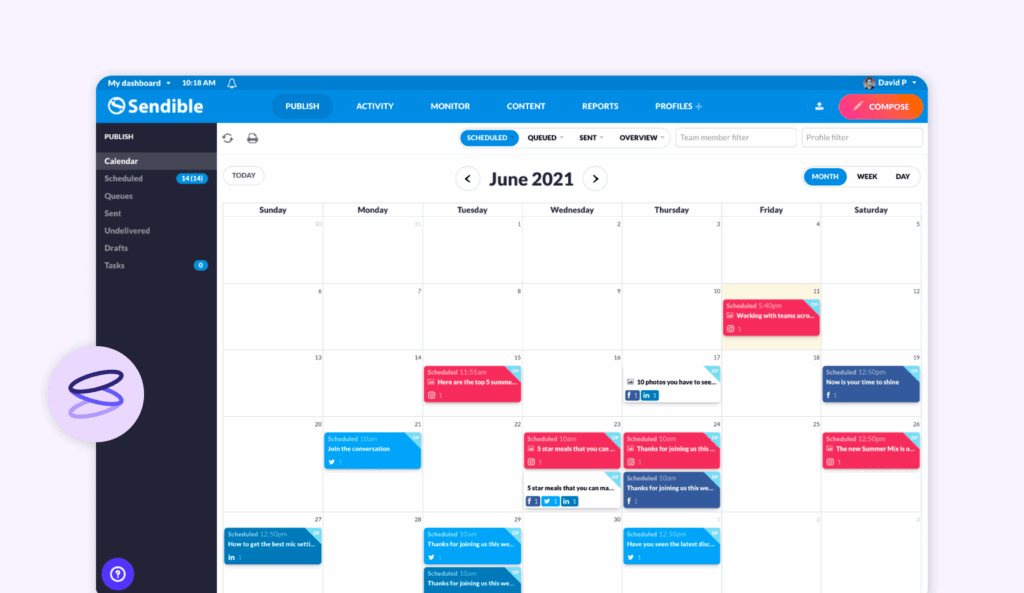
Best for: Agencies and teams managing multiple brands with client-facing needs
Founded: 2009
Pricing: Starts at $29/month
Sendible, founded in the UK in 2009, is a social media management platform designed for teams and agencies handling multiple brands or clients. It offers a priority inbox that centralizes comments, messages, and mentions across networks to streamline engagement.
Key features include bulk scheduling, a visual calendar, approval workflows, and integrations with Google Drive and Canva. It also supports white-label reporting for client-facing deliverables.
Alongside major platforms, Sendible works with Google Business Profiles and WordPress, making it suitable for a wider range of content tasks. It’s built to scale with teams and isn’t limited by per-user pricing.
Pros of Sendible:
- Google Business & WordPress support
- Clean visual scheduling
- White-labeled reporting
Cons of Sendible:
- Lack of social listening and brand monitoring
- Lack of social media competitor analysis
- Drag-and-drop post scheduling is limited to monthly view; users want more flexibility to adjust date/time easily without editing posts one by one.
- Complexity in adding custom calendars and managing personalized client logins.
3. Buffer

Best for: Solo creators or small teams who need basic publishing + engagement
Founded: 2010
Pricing: Free for 3 accounts; paid plans from $10/channel/month
Started in 2010, in California, Buffer is one of the popular social media management tools. It is a solid choice for creators and small businesses focused mainly on content publishing and audience engagement. It shines with features like unlimited scheduling, automated posting, and an AI Assistant that helps craft engaging content. The “Engage” feature lets users manage all DMs, mentions, and comments in one place, streamlining communication much like Sprout Social’s inbox. Buffer also offers clear and straightforward analytics with automated reporting, making it easy to track performance without overwhelming complexity.
Pros of Buffer:
- Clean, simple UI
- Solid for post scheduling
- Affordable for freelancers
Cons of Buffer:
- No social listening or competitor analysis
- Limited collaboration features
- Analytics less detailed than Agorapulse
- Dashboard design is not that modern
4. Sprout Social
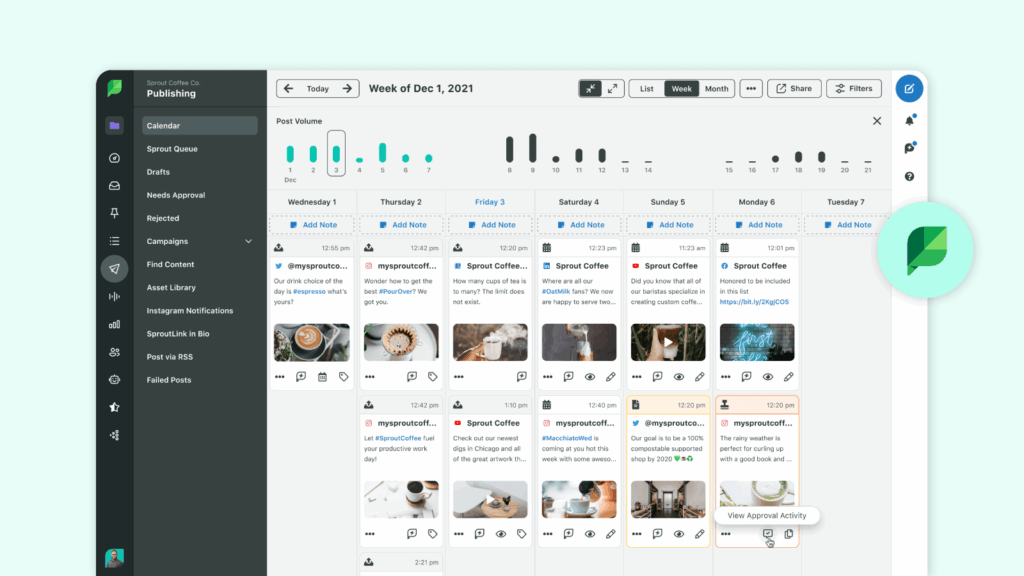
Best for: Enterprise teams needing advanced reporting, CRM features, and full-service tools
Founded: 2010
Pricing: Starts at $249/month/user
Sprout Social is a Chicago-based social media management platform that launched in 2010. Designed for businesses and enterprises, it provides a comprehensive suite of tools to manage various aspects of social media—from scheduling and publishing content to monitoring conversations and analyzing engagement across multiple platforms.
What sets Sprout Social apart is its enterprise-level experience. In addition to the core features, it offers advanced capabilities like influencer management, employee advocacy tools (enabling your team to amplify branded content), and in-depth analytics to measure performance and audience behavior.
While it’s a powerful platform packed with premium features, Sprout Social may be more than what many teams actually need—especially smaller businesses or agencies with tighter budgets or simpler workflows. For those users, its extensive toolkit can feel overwhelming or unnecessary, leading them to explore more flexible and cost-effective alternatives.
Pros of Sprout Social
- Combines publishing, scheduling, reporting, community management, and sentiment analysis in one platform.
- Scheduling tools are reliable and easy to use, with clear reporting and branded reports.
- Responsive customer support with live chat.
- Supports smooth team collaboration without overlap.
- Prioritizes comments and messages for better customer support.
- Includes a built-in link-in-bio feature, reducing need for extra tools.
- Offers context behind posts and comments for better audience insight.
- Great for agencies managing multiple clients with minimal learning curve.
Cons of Sprout Social
- Profiles can disconnect when superadmins are removed, disrupting workflows.
- LinkedIn tagging is slow and inaccurate; LinkedIn metrics sync incompletely.
- Demographic data is basic compared to native platforms.
- AI doesn’t automate content labeling enough; manual input needed.
- Some images and Instagram Reels don’t load properly or require redirection.
- Spam comment management is slow due to no bulk delete/hide option.
- Stories can’t be pre-scheduled, only posted manually.
- Pricing is high for smaller businesses.
- Occasional technical issues like delayed push notifications.
- Some advanced native platform features, especially around video and B2B tools, are limited when posting through Sprout.
5. Hootsuite
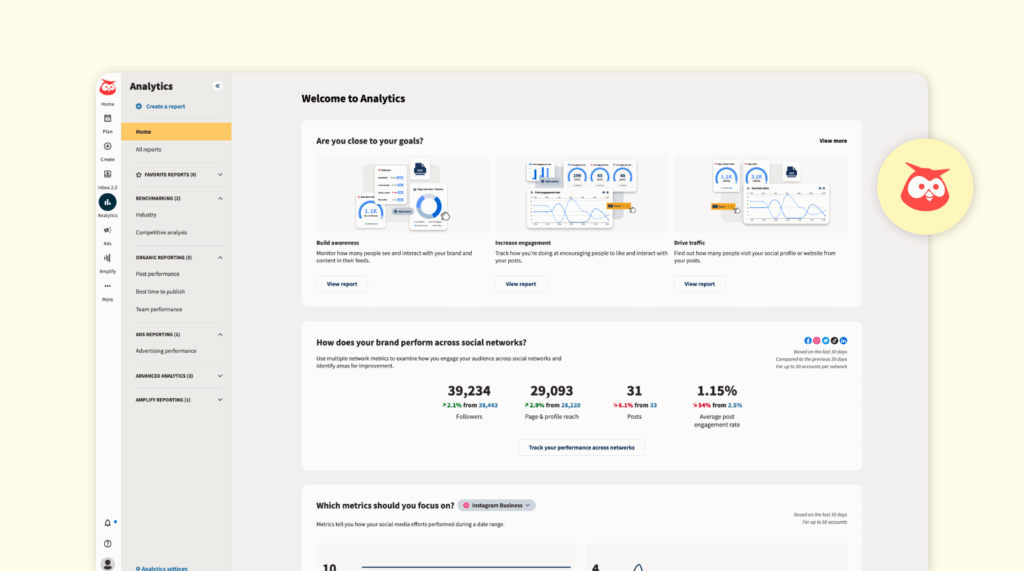
Best for: Brands that need legacy integrations or have been using the platform for years
Founded: 2008
Pricing: Starts at $99/month (1 user)
Hootsuite was one of the first platforms to offer multi-platform social media scheduling and engagement tools. Over time, it built out a large ecosystem of integrations and enterprise features. But the tool hasn’t kept pace with modern UX expectations or more flexible pricing models. Teams often find the interface clunky, and the per-user pricing makes it expensive to scale—especially if your customer service team needs access to respond across social channels.
Pros of Hootsuite:
- Large app directory and integrations
- Longstanding brand with robust help documentation
- Still offers all the basics: scheduling, analytics, and engagement
Cons of Hootsuite:
- Per-seat pricing adds up quickly
- Outdated user interface compared to newer tools
- Limited social listening and competitor tracking (unless you pay extra)
- Some features (like post approval workflows) require expensive plans
- Pricing has become less affordable for solo entrepreneurs or small businesses, with many features locked behind higher tiers.
- The app lacks key desktop features and feels clunky in comparison.
- Unified inbox can be slow, and may not sync older DMs or show all messages immediately.
- The platform may slow down when handling multiple account streams or loading Instagram inboxes.
- No flexible “posting schedule” or queue feature; auto-schedule is capped at 10 posts/day.
- Some users experience a moderate learning curve, especially those new to social media tools.
- Lacks ability to post to Google My Business alongside other platforms.
6- Zoho Social
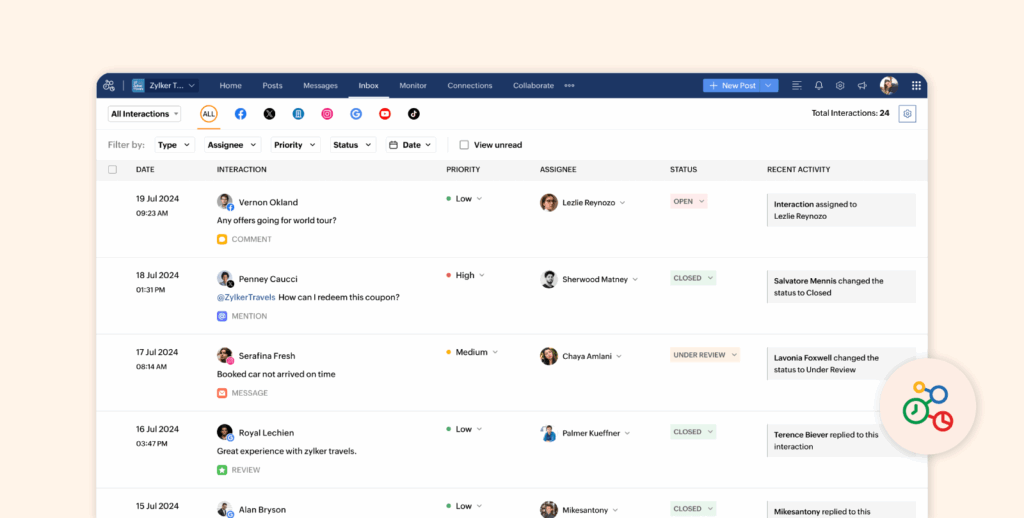
Best for: Small to mid-sized businesses using other Zoho tools
Founded: 2016
Pricing: Starts at $15/month (Standard Plan)
Zoho Social is part of the larger Zoho ecosystem, which includes CRM, email, project management, and more. If you’re already using those tools, Zoho Social integrates seamlessly—making it an appealing option for centralized workflow management. The platform covers publishing, monitoring, and basic analytics, and it includes a social inbox for managing conversations. It’s not as advanced as Agorapulse in areas like team collaboration, deep analytics, or competitive insights, but it handles day-to-day scheduling and engagement well for the price.
Beyond today’s workflows, the numbers show where things are heading. In 2025, creators are expected to generate $185 billion in ad revenue, a figure projected to grow to over $376 billion by 2030. Whichever tool you choose should be able to grow with this shift—otherwise you’ll be switching again sooner than you think.
Pros of Zoho Social:
- Affordable pricing for individuals
- Native integration with Zoho CRM and other Zoho apps
- Includes basic inbox and scheduling tools
- Useful for B2B teams already inside Zoho’s ecosystem
Cons of Zoho Social:
- The per-user pricing model can make the social inbox feature expensive for larger teams.
- Social media analytics and reporting are fairly basic
- Social listening is minimal
- Interface can feel clunky compared to newer tools
- Collaboration features are limited on lower plans
Final thoughts: How to pick the right tool for your team
After analyzing G2 reviews and testing multiple social media management tools, one thing is clear: while these tools are often adopted for scheduling and publishing content, their true value shows up when used daily by different teams—marketing, customer support, and beyond. They become more than a publishing tool; they become part of your workflow.
Whether you’re just starting out or evaluating tool for a broader team effort, here are some key questions to consider while testing any social media management platform:
1. Publishing reliability
After connecting your accounts, try scheduling a few pieces of content. Does the tool consistently publish on time without errors? If it frequently asks you to reconnect your accounts or fails to publish as scheduled, that’s a red flag. A reliable publishing system is fundamental.
2. Product development & updates
Visit the social media analytics tool’s or changelog to get a sense of how actively it’s being developed. Are there regular feature updates or improvements? A transparent, evolving roadmap often signals a product that listens to user feedback and adapts to changing needs. (Sociality.io publishes 3-5 features every month!)
3. User experience & support
Pay attention to how intuitive the tool feels during the trial. Do you get stuck easily? Is the interface cluttered or hard to navigate? Needing to contact support too often could point to UX issues. At the same time, assess the quality and speed of the support you receive—are your questions answered clearly and promptly?
4. Team collaboration features
If you plan to involve more than one person or department, test how the tool handles collaboration. Can you assign tasks, manage permissions, or share internal feedback on posts? A tool that supports teamwork without causing confusion will be easier to scale.
5. Analytics & insights
Try generating a report. Is the data presented in a useful, digestible way? Look for analytics that help you understand not just what happened, but why—and what to do next. The best tools provide context, not just numbers.
